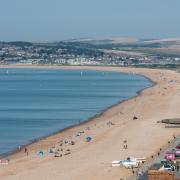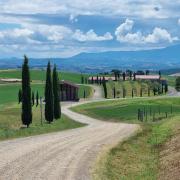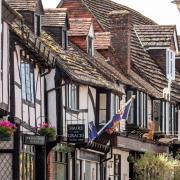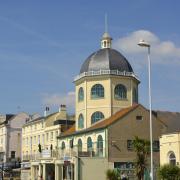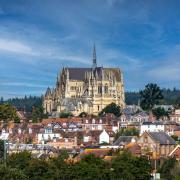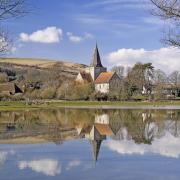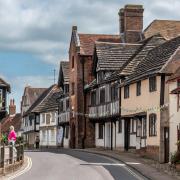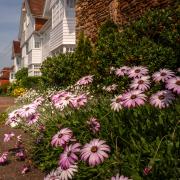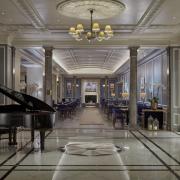Standing on a ridge by rolling Sussex countryside, Heathfield is a pretty market town with glorious views and a rich history packed with revolutionaries, eccentrics and the discovery of natural gas. But it’s a little short on pubs though so drink in those stunning vistas to the south instead

HEATHFIELD TOWN SIGN
The old Sussex name for Heathfield is Heffle and since 1315 the town has marked the arrival of spring with a cuckoo fair. Tradition has it that spring can only arrive once ‘Dame Heffle’ has released a cuckoo. That’s what this sign depicts.

TOWN CENTRE
Heathfield High Street is also known as the A265, a road that travels from east to west on a ridge from Heathfield to Hurst Green. It’s a busy and diverse High Street and, in many ways, it bucks the trend of others in Sussex in that it still has a fishmonger, a baker, an ironmonger and a butcher. Not far away are three reasonably large supermarkets.

GIBRALTAR TOWER
Looking over the wall from Tower Street you can see Gibraltar Tower standing in private property. The story goes that when Frances Newbery bought Bailey Park in 1791 he changed the name to Heathfield Park and began work erecting this folly. Why? Well, the previous owner was George Augustus Eliot, who had been Governor of Gibraltar during the great siege by the Spanish from 1779 - 1783, after which he was honoured as Lord Heathfield of Gibraltar. To confuse matters further, the folly was originally called Heathfield Tower.

FORGOTTEN RAILWAY
The arrival of the railway in 1880 should really have heralded a golden age for the town and, for a while, it did. It was part of the London, Brighton and South Coast Railway forming part of the line extension from Hailsham to Eridge. Sadly, the number of passengers never quite reached the levels hoped for and, as part of Dr Beeching’s infamous cuts, the line was closed in 1965. The platforms and lines are long gone, replaced by a car park and industrial estate but the beautiful booking office still stands, although it is currently lying empty.

THE WEALDEN DALLAS?
Railway workers in 1895 were drilling near the station looking for water when they stumbled across a natural gas deposit. There were high hopes for the fortunes of the town but the deposits were relatively small, so it was never going to turn Heathfield into a Wealden version of Dallas. The streetlights of the town were lit with the gas along with lighting in about 100 homes. But by 1963, the supplies were running low and the wellhead was permanently sealed off. This standpipe near Ghyll Road is the only evidence of this once-flourishing industry.

HEATHFIELD TAVERN
One of the most unusual features of this town is its almost complete lack of pubs, which is very unusual for Sussex. The Heathfield Tavern, at the junction of Station Road and Hailsham Road, appears to be the only one in town, and even that is comparatively far out. Why is that? It seems that the Union Church, still standing today, leased out land to local businesses on the High Street, but completely banned the building of any licensed premises.

JACK CADE'S REBELLION
Five years before the first of the Wars of the Roses, Jack Cade led a Rebellion against the government of King Henry VI in 1450. Cade marched on London with an army of men from the south-east of England intent on forcing ‘traitors’ out of power. Unfortunately, when he and his men arrived in the capital, the rebel army started looting the city. Londoners didn’t take too kindly to this and fought back hard. The King offered to pardon them if they would all go home. Cade, though, was tracked down and injured badly when he was caught, eventually dying from his injuries before he could be brought to London for trial. But that didn’t stop his captors seeking justice. His dead body was tried, found guilty, beheaded and quartered. This monument supposedly marks the spot where he was captured not far from the Half Moon at the Jack Cade pub, in what we now call Cade Street.
ALL SAINTS CHURCH
In the village of Old Heathfield is the 13th century All Saints Church. Obviously, it’s not all 13th century, but the tower certainly is. It’s an impressive structure.
In the churchyard of All Saints is a fine example of a so-called Harmer grave. In the late 18th century, local potter Jonathan Harmer devised a method to attach terracotta plaques to gravestones, enhancing their beauty. A number can be found in several East Sussex villages, and in two in Kent - Brookland and Lamberhurst - but nowhere else in the country. Sadly, when Jonathan died in 1839 he took the secrets of his method to the grave.

SUGAR LOAF
One of local legend ‘Mad Jack’ Fuller’s creations, the Sugar Loaf, or Fuller’s Point, stands in a field at Woods Corner, five miles or so outside Heathfield. The accepted story is that Fuller made a bet that he could see the spire of St Giles Church at Dallington from his house in Brightling. When he realised he was mistaken, he sent workmen out to hurriedly build this folly in order to win the bet. It is named after a sugar loaf because up until the late 19th century sugar was sold in a conical loaf form, roughly this shape. It was used as a two-story dwelling by the Crouch family in the middle of the 19th century which, considering it is only 15ft in diameter at its base, is mind-boggling.
CORONATION MEDAL
When King Edward VII was crowned in 1902, a special Coronation medal was struck depicting the new king and his queen, Alexandra. The reverse of the coin was dedicated to Heathfield and the recently-discovered natural gas reserves below the town.
LOCAL RESIDENTS

Peter Thompson – ‘It’s a great community here, but I don’t like all the expansion. There are a lot of new builds and they’re building more and more. We’re going to end up with a more congested High Street. We do have a lot of facilities here - shops, a good leisure centre, and a community centre. It has good schools too. We are midway between two major towns - Tunbridge Wells and Eastbourne - but they used to have bus services that ran through here from Hawkhurst to Eastbourne and to Brighton, and it’s all been reduced. But we’re lucky, we have three supermarkets.’

Paul Roberts – ‘It’s a small town with a friendly and welcoming community. Geographically, it’s well-placed and easy to get to other places, but only by road unfortunately. Public transport is a problem. Development has affected us less here than some other places.’





